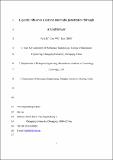| dc.contributor.author | Liu, Fei | |
| dc.contributor.author | Wu, Dan | |
| dc.contributor.author | Chen, Ken | |
| dc.date.accessioned | 2016-06-27T20:46:43Z | |
| dc.date.available | 2016-06-27T20:46:43Z | |
| dc.date.issued | 2014-10 | |
| dc.date.submitted | 2014-07 | |
| dc.identifier.issn | 1388-0764 | |
| dc.identifier.issn | 1572-896X | |
| dc.identifier.uri | http://hdl.handle.net/1721.1/103365 | |
| dc.description.abstract | The interactions between nanomaterials and biological membranes are important for the safe use of nanomaterials. We explore the nano–bio interface by studying the penetration of a carbon nanotube (CNT) coated with ligands through a lipid bilayer. With a dissipative particle dynamics model, the mechanism of ligands influencing nano–bio interaction is analyzed. The CNTs with different ligands are tested. The simulation shows that the increase of the total number of ligand particles decreases the capability of a CNT penetrating through a membrane. For the CNTs with the same number of ligand particles, the arrangements of their ligands determine their behaviors. The asymmetrical pattern generates an upside down phenomenon, which requires more energy to get through the membrane; the uniform distribution penetrates through a membrane with less difficulty. Decreasing the stiffness, the length of ligands or preferring hydrophobic ligands increases the penetration capability of CNTs. | en_US |
| dc.description.sponsorship | Singapore-MIT Alliance for Research and Technology (SMART) | en_US |
| dc.description.sponsorship | China. Fundamental Research Funds for the Central Universities (Grant No. CDJZR14905502) | en_US |
| dc.description.sponsorship | National Natural Science Foundation (China) (Grant No. 51175278) | en_US |
| dc.publisher | Springer Netherlands | en_US |
| dc.relation.isversionof | http://dx.doi.org/10.1007/s11051-014-2692-8 | en_US |
| dc.rights | Article is made available in accordance with the publisher's policy and may be subject to US copyright law. Please refer to the publisher's site for terms of use. | en_US |
| dc.source | Springer Netherlands | en_US |
| dc.title | Ligands influence a carbon nanotube penetration through a lipid bilayer | en_US |
| dc.type | Article | en_US |
| dc.identifier.citation | Liu, Fei, Dan Wu, and Ken Chen. "Ligands influence a carbon nanotube penetration
through a lipid bilayer." Journal of Nanoparticle Research November 2014, 16:2692. | en_US |
| dc.contributor.department | Massachusetts Institute of Technology. Department of Biological Engineering | en_US |
| dc.contributor.mitauthor | Liu, Fei | en_US |
| dc.relation.journal | Journal of Nanoparticle Research | en_US |
| dc.eprint.version | Author's final manuscript | en_US |
| dc.type.uri | http://purl.org/eprint/type/JournalArticle | en_US |
| eprint.status | http://purl.org/eprint/status/PeerReviewed | en_US |
| dc.date.updated | 2016-05-23T12:08:14Z | |
| dc.language.rfc3066 | en | |
| dc.rights.holder | Springer Science+Business Media Dordrecht | |
| dspace.orderedauthors | Liu, Fei; Wu, Dan; Chen, Ken | en_US |
| dspace.embargo.terms | N | en |
| mit.license | PUBLISHER_POLICY | en_US |
